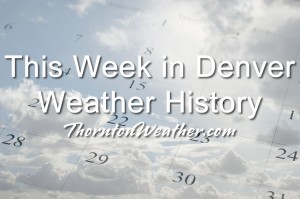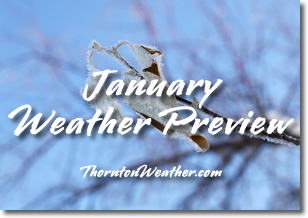
Damaging wind events dominate our look back at this week in Denver weather history. Also making appearances are extreme cold and significant snowstorms.
14-21
In 1930…a protracted cold spell occurred when low temperatures plunged below zero on 8 consecutive days. The coldest low temperatures of 20 degrees below zero on the 17th and 19 degrees below zero on the 16th were record minimums for the dates. High temperatures during the period ranged from 18 on the 18th to zero on the 20th. Two degrees on the 15th was a record low maximum temperature for the date.
15-23
In 1962…a protracted cold spell kept metro Denver in the deep freeze for more than a week. From the 15th thru the 23rd…low temperatures were zero or below for 9 consecutive days…but a daily record low was set only on the 22nd when the temperature dipped to 14 degrees below zero. A record low maximum for the date was also set on the 22nd when the temperature climbed to only 11 degrees. The coldest high temperature was 3 degrees above zero on the 21st…which did not break the record. The protracted cold was broken for only a few hours on the afternoon of the 20th when Chinook winds warmed the temperature to a high of 38 degrees before another surge of cold arctic air plunged temperatures back into the deep freeze that evening. The severe cold caused much damage to water systems. A woman was frozen to death at Morrison. There were other deaths attributable to the weather…including traffic deaths and heart attacks from overexertion.
18-20
In 1958…snowfall totaled 6.9 inches at Stapleton Airport where east-northeast winds gusted to 26 mph on the 18th.
18-24
In 2005…a week of mid-winter unseasonably warm weather pushed high temperatures into the 60’s or more on all but one day. During the period…the highest temperature of 70 degrees on the 20th was a new record maximum for the date. Low temperatures remained above freezing on 4 of the days.
19-20
In 1935…snowfall of only 0.8 inch during the evening of the 19th was the only measurable snowfall of the month. The light snow developed behind an arctic cold front as temperatures plunged to a low of 13 degrees below zero on the 20th. High temperature of only 2 degrees on the 20th was a record low maximum for the date. Northeast winds were sustained to 16 mph on the 19th.
In 1986…Chinook winds gusting to 39 mph at Stapleton International Airport provided record breaking warmth. The warmest temperature of the month…68 degrees on the 19th…was also a record high for the date. The low temperature of 41 degrees on the 20th equaled the record high minimum for the date.
In 1991…a strong cold front moved south across metro Denver. Upslope conditions produced 3 to 6 inches of snow along the Front Range with 5 inches in Westminster and 4 inches in Thornton. Snowfall measured 4.9 inches at Stapleton International Airport where north winds gusted to 31 mph.
20
In 1894…northwest winds were sustained to 40 mph with gusts to 45 mph in the city.
In 1911…west Chinook winds sustained to 46 mph warmed the temperature to a high of 62 degrees.
In 1975…a warm Chinook wind produced a west wind gust to 53 mph at Stapleton International Airport. Winds were much stronger near the foothills…where 80 mph winds in Boulder caused damage to homes…buildings…power lines… And autos.
In 1986…high winds buffeted the foothills from Denver north. The strongest reported wind was 72 mph in Fort Collins. A wind gust to 39 mph was reported at Stapleton International Airport in Denver.
In 1996…high winds developed for a short time in the Front Range foothills in the wake of a weak upper level disturbance. Wondervu recorded a peak wind gust to 90 mph… While winds gusted to 84 mph atop squaw mountain near Idaho Springs. West winds gusted to only 29 mph at Denver International Airport.
In 2011…a snowboarder and his dog were killed when he triggered an avalanche in the backcountry northeast of Berthoud Pass.
20-21
In 1973…a major storm produced 7.5 inches of snowfall at Stapleton International Airport where north winds gusted to 32 mph causing some blowing snow.
In 2002…high winds developed over portions of the northern mountains and Front Range foothills. Several trees were blown down in Gilpin County along State Highways 119 and 46. Wind gust reports included: 90 mph 11 miles north of Central City…83 mph near Fritz Peak…76 mph at Aspen Springs…and 80 mph at Nederland. West winds gusted to only 39 mph at Denver International Airport on the 20th.
Continue reading January 20 to January 26: This Week in Denver Weather History


 As we begin the new year the winter chill begins to set in. While January can see its share of extremes, the month historically sees stable temperatures and is usually relatively dry.
As we begin the new year the winter chill begins to set in. While January can see its share of extremes, the month historically sees stable temperatures and is usually relatively dry.